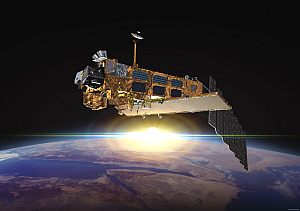KIT researchers and their cooperation partners at the universities of Cambridge, United Kingdom, and Utrecht, the Netherlands, have succeeded in obtaining new insight into vertical air mass circulation by satellite-borne measurements of “heavy” water vapor in the upper atmosphere. These findings serve to understand the interactions between climate change and the chemistry of the stratospheric ozone layer. Now, the results have been published in the “Nature Geoscience” journal.
Normally, water freezes at the very cold interface between the troposphere, the bottom layer of the atmosphere where weather happens, and the above lying stratosphere, i.e. at an altitude of about 10 to 15 km at the latest, and clouds form. In their studies, KIT scientists and their cooperation partners at Cambridge and Utrecht make use of the effect that so-called “heavy” water (HDO) freezes more rapidly than normal water when water vapor condenses to ice.
Therefore, the concentration of the main isotope H2O, in comparison to “heavy” water, is higher in the remaining water vapor than in air masses where no condensation and no cloud formation have taken place. In this way, scientists can pursue the way of the water vapor from the troposphere to the above lying much dryer stratosphere.
Based on the measured ratios between “heavy” water HDO and the main isotope H2O, the scientists have now been able to determine the role of cloud formation in the transport of water to the stratosphere. Due to ice and cloud formation at the interface between troposphere and stratosphere, usually extremely dry air from below enters the stratosphere. The measurements however show that the HDO/H2O water isotope ratio is subject to high seasonal variations. This suggests that ice particles in tropical thunderstorm clouds reach very high altitudes by air lift. There, the ice particles evaporate again and contribute to the humidification of the stratosphere.
“Water and its isotopes play a key role in the complex chemical composition of the atmosphere of the Earth, because water is a major greenhouse gas and its concentrations in the upper troposphere and lower stratosphere are of highest relevance to climate change,” explains Dr. Gabriele Stiller, who heads a working group at the Institute of Meteorology and Climate Research (IMK) of Karlsruhe Institute of Technology (KIT).
At the IMK, the measurements made by the own-conceived MIPAS instrument (Michelson Interferometer for Passive Atmospheric Sounding), one of the major instruments on board of the ENVISAT European environmental satellite, are evaluated. Since 2002, this satellite has been orbiting at an altitude of about 800 km and monitoring and measuring more than 30 trace gases at the same time. Apart from ozone and water vapor, these trace gases include nitrogen oxides and various chlorofluorocarbons. As MIPAS measures the infrared radiation (thermal radiation) emitted by the molecules, it can record spectra during both day and night.
Water Isotopes
Compared to “normal” water H2O, “heavy” water HDO contains one hydrogen atom (H) instead of two and a “heavy” deuterium atom (D). Contrary to the hydrogen atom, the atomic nucleus of which consists of a single proton only, the deuterium nucleus additionally contains a neutron. Normally, even ocean water contains about 0.03% HDO only. In the atmosphere, this ratio is even smaller and highly variable due to various evaporation and condensation processes.
Reference:
“Tropical dehydration processes constrained by the seasonality of stratospheric deuterated water”, Jörg Steinwagner, Stephan Fueglistaler, Gabriele Stiller, Thomas von Clarmann, Michael Kiefer, Peter-Paul Borsboom, Aarnout van Delden, and Thomas Röckmann (2010), Nature Geoscience, 3, DOI: 10.1038/NGEO822, published online: 28 March 2010.
In close partnership with society, KIT develops solutions for urgent challenges – from climate change, energy transition and sustainable use of natural resources to artificial intelligence, sovereignty and an aging population. As The University in the Helmholtz Association, KIT unites scientific excellence from insight to application-driven research under one roof – and is thus in a unique position to drive this transformation. As a University of Excellence, KIT offers its more than 10,000 employees and 22,800 students outstanding opportunities to shape a sustainable and resilient future. KIT – Science for Impact.

